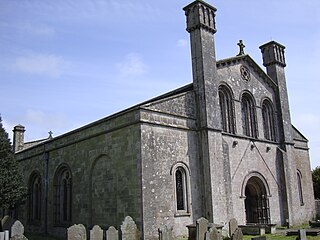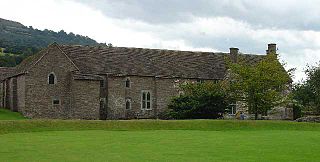Related Research Articles

The Red Book of Hergest, Oxford, Jesus College, MS 111, is a large vellum manuscript written shortly after 1382, which ranks as one of the most important medieval manuscripts written in the Welsh language. It preserves a collection of Welsh prose and poetry, notably the tales of the Mabinogion and Gogynfeirdd poetry. The manuscript derives its name from the colour of its leather binding and from its association with Hergest Court between the late 15th and early 17th century.
Eudaf Hen is a figure of Welsh tradition. He is remembered as a King of the Britons and the father of Elen Luyddog and Conan Meriadoc in sources such as the Welsh prose tale The Dream of Macsen Wledig and Geoffrey of Monmouth's Latin chronicle Historia Regum Britanniae. He also figures into Welsh genealogies. Geoffrey of Monmouth calls him Octavius, a corruption and faux-Latinization of Old Welsh/Breton Outham. According to the medieval Welsh genealogy from Mostyn MS. 117, Eudaf was a direct ancestor of King Arthur.

Cadair Idris or Cader Idris is a mountain in the Meirionnydd area of Gwynedd, Wales. It lies at the southern end of the Snowdonia National Park near the town of Dolgellau. The peak, which is one of the most popular in Wales for walkers and hikers, is composed largely of Ordovician igneous rocks, with classic glacial erosion features such as cwms, moraines, striated rocks, and roches moutonnées.
Lewys Glyn Cothi, also known as Llywelyn y Glyn, was a prominent 15th-century Welsh poet who composed numerous poems in the Welsh language. He is one of the most important representatives of the Beirdd yr Uchelwyr or Cywyddwyr ("cywydd-men"), the itinerant professional poets of the period between the 1284 Statute of Rhuddlan and c. 1600.
Dafydd ap Edmwnd was one of the most prominent Welsh language poets of the Later Middle Ages.
Gwilym ab Ieuan Hen was a Welsh-language poet during the time of the Beirdd yr Uchelwyr, the professional "Poets of the Nobility".

Tudur Penllyn was a Welsh language poet during the time of the Beirdd yr Uchelwyr, the professional poets of the late Middle Ages.
The Battle of Mechain was fought in Powys, Wales, in 1070, for rule of the Welsh kingdoms of Gwynedd and Powys. The battlefield may be near Llanfechain in northern Powys. A written account is included in the Brut y Tywysogion, the medieval Welsh chronicle of the princes. It is also referred to in the work of medieval poets such as Lewys Glyn Cothi.
Evan David Jones CBE FSA was the Librarian of the National Library of Wales in Aberystwyth from 1958 to 1969.
In early Arthurian literature, Madoc ap Uthyr is the son of Uther Pendragon, brother to King Arthur and father of Eliwlod. He is memorialized with "The Death Song of Madawg" from the Book of Taliesin, which laments his death at Erof's hands; he is also mentioned in the poem Arthur and the Eagle.
Llywelyn is a Welsh personal name, which has also become a family name most commonly spelt Llewellyn. The name has many variations and derivations, mainly as a result of the difficulty for non-Welsh speakers of representing the sound of the initial double ll.

The White Book of Hergest was an important Welsh manuscript compiled in c. 1450. It contained many Welsh poems and prose texts and was a significant source for several antiquaries of the 17th and 18th centuries, but disappeared in the early 19th century, probably being destroyed in a fire in a London bookbinder's shop in around 1810.

Sir Roger Vaughan of Tretower Court, was the son of Welsh noblewoman Gwladys ferch Dafydd Gam and Sir Roger Vaughan of Bredwardine, who fought and died with Gwladys's father, Dafydd Gam in the Battle of Agincourt in 1415.

The Coelbren y Beirdd is a script created in the late eighteenth century by the literary forger Edward Williams, best known as Iolo Morganwg.

Saint Egwad was a 7th-century Catholic bishop and Saint of Wales.
Peniarth 109 is a Welsh manuscript from the second half of the 15th century, in the hand of the poet Lewis Glyn Cothi. It is part of the Peniarth Manuscripts Collection at the National Library of Wales.

The Jones of Faerdref Uchaf family is a Welsh gentry family from the parish of Llandrillo-yn-Edeirnion, Merionethshire. They are a cadet branch of the Hughes of Gwerclas family, descending from the younger brother of the 7th Baron of Kymmer-yn-Edeirnion, Gruffydd ap Rhys ab Ieuan, 'Baron of Crogen and Branas', who was famed for his pilgrimage to Santiago di Compostella. He was a Lancastrian and later supported his kinsman Henry Tudor. He was a patron of the bards, most notably Lewys Glyn Cothi.
Lewys is a Welsh masculine given name. Notable people with the name include:
Tegau Eurfron was a legendary Celtic queen of the Early Christian era who was the wife King Caradoc Vreichvras, whose kingdom is disputed but may have been Gwent or one of the Breton kingdoms.
References
- ↑ Morris, Lewis. Celtic Remains, Cambrian Archaeological Association, 1878, p.163
- ↑ Williams, David. The History of Monmouthshire, 1796
- ↑ Jones, Edward. Musical and poetical relicks of the Welsh Bards, Office of Robes, St. James's Palace, 1808, p.10
- ↑ The Arthur of the Welsh: The Arthurian Legend in Medieval Welsh Literature, University of Wales Press, 2020, p.57 ISBN 9781786837349
- ↑ Cothi, Lewys Glyn. The Poetical Works of Lewis Glyn Cothi, Cymmrodorion, 1837, p.136
- ↑ Arthur in Early Welsh Poetry (Nerys Ann Jones, ed.) MHRA, Library of Medieval Welsh Literature, 2019, p.113 ISBN 9781781889084